New Zealand is unprepared for a demographic shift that will see the over-65 population almost double within 25 years, according to a researcher warning of looming crises in housing, healthcare and aged care.
Speaking on Q+A earlier today, Helen Clark Foundation researcher Kali Mercier said the country faces a shortage of 12,000 aged care beds by 2032 — just seven years away.
"We're not really planning for that in terms of our infrastructure provision at all," Mercier said when asked if New Zealand is ready for an ageing population.
"The short answer is no, we're not."
The strain on healthcare will be immense as those over 85 require 16 times as much healthcare spending per capita as 40-year-olds, according to analysis by BERL.
"We're already buckling under the strain for healthcare," Mercier said.

"If we're going to have three or four times more 85-year-olds, we are going to need significantly more health infrastructure, and we don't seem to be catching up in any meaningful way at the moment."
She said the aged care sector was already struggling with many facilities run by charities, unable to maintain current operations — let alone expand capacity.
Regional challenges vary dramatically. Nelson Tasman's over-65 population is growing at triple the national rate, while Auckland will need to accommodate an additional 200,000 older residents within 25 years, the researcher noted.
Smaller councils face particular pressure as they'll have fewer working people to fund services through rates, while older residents on fixed incomes struggle with higher costs.
Urban design, homes crucial to retirees
Mercier also pointed out that home ownership among over-65s is plummeting. While 82% owned their homes in 2001, this will drop to 50% within a short period, she said.

"We've had a policy of 'ageing in place' in New Zealand since the late '90s. It's much nicer for people to be able to age at home than to be in a hospital or an aged-care facility.
"It's also a lot cheaper — it costs something like $20 a day to keep someone at home. Having someone in aged-care is $180 a day, hospital was $1000 a day.
"So we need to be all working together to make sure we're putting that money up front where it counts the most, so that we can make savings throughout the systems."
She added that denser urban design with more accessible housing was important too.
"Councils have a role to play as well, to make sure that we're zoning for a whole different— for different sizes of housing and different formats of housing throughout, so that we're not just building large three-bedroom houses on plots," Mercier said.

"We can actually make a lot of savings by designing our urban areas to be good for active ageing, and to keep — allow people to be able to age in-place in their homes.
"Some of our urban areas are accessible, walkable, good public transport, quite dense, have shops available, and not just suburban areas, but actually you can get around one foot.
"Then older people can stay in their homes longer, and that saves us money across the whole system. And it also makes ageing a lot more pleasant for people."
For the full interview, watch the video above
Q+A with Jack Tame is made with the support of New Zealand On Air


















SHARE ME